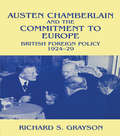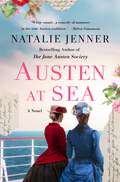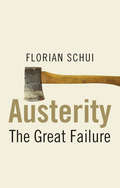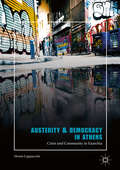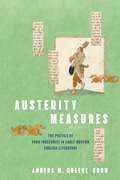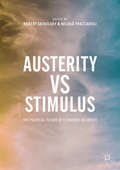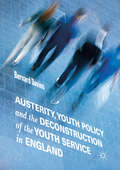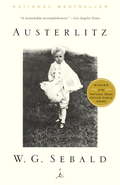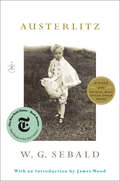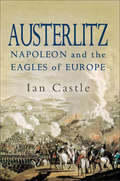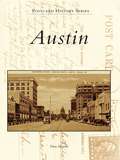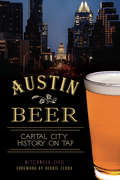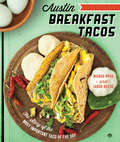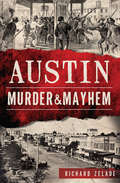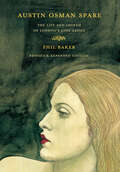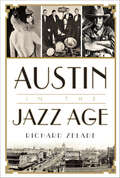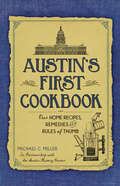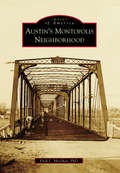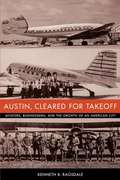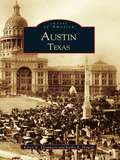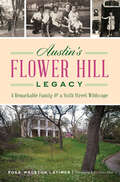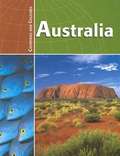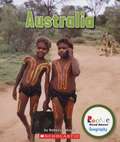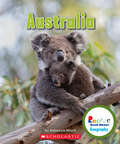- Table View
- List View
Austen Chamberlain and the Commitment to Europe: British Foreign Policy 1924-1929
by Richard S. Grayson Dr Richard GraysonThis is a study of Austen Chamberlain's term of office as Stanley Baldwin's Foreign Secretary from 1924-29. It is argued that Chamberlain's priority was a two-stage policy in Western Europe, which aimed at pacifying both France and Germany, as well as encouraging the League of Nations.
Austen at Sea: A Novel
by Natalie JennerTwo pairs of siblings, devotees of Jane Austen, find their lives transformed by a visit to England and Sir Francis Austen, her last surviving brother and keeper of a long-suppressed, secret legacy.In Boston, 1865, Charlotte and Henrietta Stevenson, daughters of a Massachusetts Supreme Court Justice, have accomplished as much as women are allowed in those days. Chafing against those restrictions and inspired by the works of Jane Austen, they start a secret correspondence with Sir Francis Austen, her last surviving brother, now in his nineties. He sends them an original letter from his sister and invites them to come visit him in England.In Philadelphia, Nicholas & Haslett Nelson—bachelor brothers, veterans of the recent Civil War, and rare book dealers—are also in correspondence with Sir Francis Austen, who lures them, too, to England, with the promise of a never-before-seen, rare Austen artifact to be evaluated.The Stevenson sisters sneak away without a chaperone to sail to England. On their ship are the Nelson brothers, writer Louisa May Alcott, Sara-Beth Gleason—wealthy daughter of a Pennsylvania state senator with her eye on the Nelsons—and, a would-be last-minute chaperone to the Stevenson sisters, Justice Thomas Nash. It's a voyage and trip that will dramatically change each of their lives in ways that are unforeseen, with the transformative spirit of the love of literature and that of Jane Austen herself.
Austerity
by Florian SchuiAusterity is at the center of political debates today. Its defenders praise it as a panacea that will prepare the ground for future growth and stability. Critics insist it will precipitate a vicious cycle of economic decline, possibly leading to political collapse. But the notion that abstinence from consumption brings benefits to states, societies, or individuals is hardly new. This book puts the debates of our own day in perspective by exploring the long history of austerity-a popular idea that lives on despite a track record of dismal failure. Florian Schui shows that arguments in favor of austerity were-and are today-mainly based on moral and political considerations, rather than on economic analysis. Unexpectedly, it is the critics of austerity who have framed their arguments in the language of economics. Schui finds that austerity has failed intellectually and in economic terms every time it has been attempted. He examines thinkers who have influenced our ideas about abstinence from Aristotle through such modern economic thinkers as Smith, Marx, Veblen, Weber, Hayek, and Keynes, as well as the motives behind specific twentieth-century austerity efforts. The persistence of the concept cannot be explained from an economic perspective, Schui concludes, but only from the persuasive appeal of the moral and political ideas linked to it.
Austerity & Democracy in Athens: Crisis and Community in Exarchia
by Monia CappucciniThis book, based on an empirical form of narration, outlines a short-medium term analysis of the social impact of austerity politics on urban life. . Set in Exarchia, a radical and anti-authoritarian neighbourhood located within the city centre of Athens, Greece, this is an ethnography examining the social struggles and grassroots mobilizations that emerged locally during the crisis. Based on over two years of fieldwork between November 2012 and early 2014, the author brings together participant observation and a period of research-action in one of Exarchia's stekia. One particular pedestrian street is used as a case study - 'Odos Tsamadou' is located near Exarchia Square and here multiple social centres and political activity converge to allow the neighbourhood's climate of solidarity and reciprocity to fully emerge. This book is specifically targeted at academics specialized in the social sciences, ethnography, cultural anthropology and urban studies and more generally at anyone interested in contemporary urban and social development.
Austerity Measures: The Poetics of Food Insecurity in Early Modern English Literature
by Anders M. Greene-CrowExplores how early modern writers used poetry to fight food insecurityAusterity Measures explores how early modern writers used poetic form as a tool to fight extreme food insecurity. Authors such as Thomas Tusser, George Herbert, Robert Herrick, Anne Bradstreet, and Thomas Tryon witnessed the privatization of public farmland, rising food prices amidst uncontrolled inflation, mass starvation in nascent North American colonies, and the racist violence of the Caribbean plantation slavery system. Anders M. Greene-Crow shows how these authors experimented with literary form in an effort to change readers’ beliefs and behaviors with regard to food ethics.By examining this history, Greene-Crow sheds new light on both modern-day food ethics and activism’s place in literary writing. This book traces how authors’ solutions to food insecurity turned away from structural models of communal care and toward the now-dominant consumer-capitalist model championing individual dietary choice. Simultaneously, he reveals why literary criticism began to discount literature’s power as a tool for social change. The New Critical school, whose close reading methodology dominates literary analysis, arose out of Southern Agrarianism, a movement that sought to return the South to antebellum structures of racial hierarchy and labor exploitation that took shape in the early modern period. These intersectional labor politics underlie close reading, continuing to limit critics’ understanding of how literary form produces social change, and reinforcing the scarcity culture of literature departments today.By recovering poetry’s role as a force for affecting readers’ relationship to one of their most basic needs—the need to eat—Austerity Measures develops an alternative methodology that takes writers’ material conditions into account in analyzing form.
Austerity vs Stimulus: The Political Future of Economic Recovery
by Robert Skidelsky Nicolò FraccaroliThis timely book debates the economic and political logic of the austerity policies that have been implemented in the UK and in the Eurozone since 2010 and asks whether there is any alternative for these countries in the years ahead. The work reconsiders the austerity versus stimulus debate through the voices of those who proposed the successful idea of expansionary austerity and those who opposed it. The editors have brought together a collection of articles written by some of the most notable figures in the discipline, including the likes of Alberto Alesina, Ken Rogoff, Tim Besley, David Graeber, Vince Cable, and Paul Krugman. The book also features the debate between Niall Ferguson and Robert Skidelsky. These leading thinkers unveil a world where economists are far from agreeing on economic policy, and where politics often dominates the discussion. The question of whether the British government should have opted for austerity runs through the book, as well as how sustained economic recovery should be encouraged in the future. Scholars, students and members of the general public with an interest in the financial crisis and its lingering aftermath will find this work invaluable.
Austerity, Youth Policy and the Deconstruction of the Youth Service in England
by Bernard DaviesThis timely book presents a vital analysis of the politics, policy and practice of youth work services in England and the impacts of the austerity agenda introduced after the 2007-08 financial crisis. Davies frames his research within the ideological, political and economic context of the last decade, contemplating the prescriptions of neoliberalism, and various other socio-political developments. He illustrates how wider government policies, programmes and initiatives have marred the purposes and methods of the Youth Service and youth work facilities, forging connections with what this means for young people and youth work. Unique in its depth and detail, this book is one of the first comprehensive, evidenced and up-to-date accounts of UK Youth Policy. It is an essential and invaluable resource for youth educators, researchers, service managers, practitioners and activists, as well as scholars and students of youth studies, social policy, public policy, and history.
Austerlitz
by W. G. SebaldFrom one of the undisputed masters of world literature, a haunting novel of sublime ambition and power about a man whose fragmentary memories of a lost childhood lead him on a quest across Europe in search of his heritage.Jacques Austerlitz is a survivor - rescued as a child from the Nazi threat. In the summer of 1939 he arrives in Wales to live with a Methodist minister and his wife. As he grows up, they tell him nothing of his origins, and he reaches adulthood with no understanding of where he came from. Late in life, a sudden memory brings him the first glimpse of his origins, launching him on a journey into a family history that has been buried.The story of Jacques Austerlitz unfolds over the course of a 30-year conversation that takes place in train stations and travellers' stops across England and Europe. In Jacques Austerlitz, Sebald embodies the universal human search for identity, the struggle to impose coherence on memory, a struggle complicated by the mind's defences against trauma. Along the way, this novel of many riches dwells magically on a variety of subjects - railway architecture, military fortifications, insects, plants and animals, the constellations, works of art, a small circus and the three cities that loom over the book, London, Paris and Prague - in the service of its astounding vision.From the Hardcover edition.
Austerlitz
by W.G. SebaldW. G. Sebald&’s celebrated masterpiece, &“one of the supreme works of art of our time&” (The Guardian), follows a man&’s search for the answer to his life&’s central riddle. &“Haunting . . . a powerful and resonant work of the historical imagination . . . Reminiscent at once of Ingmar Bergman&’s Wild Strawberries, Kafka&’s troubled fables of guilt and apprehension, and, of course, Proust&’s Remembrance of Things Past.&”—Michiko Kakutani, The New York Times One of The New York Times&’s 10 Best Books of the 21st Century • A Los Angeles Times, Entertainment Weekly, and New York Magazine Best Book of the Year Winner of the National Book Critics Circle Award, Koret Jewish Book Award, Independent Foreign Fiction Prize, and Jewish Quarterly Wingate Literary Prize A small child when he comes to England on a Kindertransport in the summer of 1939, Jacques Austerlitz is told nothing of his real family by the Welsh Methodist minister and his wife who raise him. When he is a much older man, fleeting memories return to him, and obeying an instinct he only dimly understands, Austerlitz follows their trail back to the world he left behind a half century before. There, faced with the void at the heart of twentieth-century Europe, he struggles to rescue his heritage from oblivion. Over the course of a thirty-year conversation unfolding in train stations and travelers&’ stops across England and Europe, W. G. Sebald&’s unnamed narrator and Jacques Austerlitz discuss Austerlitz&’s ongoing efforts to understand who he is—a struggle to impose coherence on memory that embodies the universal human search for identity. This tenth-anniversary edition features a new Introduction by James Wood.
Austerlitz: Napoleon and The Eagles of Europe
by Ian CastleIn this authoritative and beautifully illustrated new account of Napoleon's greatest victory and the campaign that preceded it, Ian Castle sheds new light on the actions of the commanders and questions the assumptions—and explores the myths—that have shaped our understanding of the event ever since. His account follows every twist and turn of a war that was fought out across central Europe two centuries ago. In particular he reconstructs the course of the action in every sector of the Austerlitz battlefield, using French, Austrian and Russian records, and re-evaluates the place of the battle in the history and mythology of the Napoleonic era.
Austin
by Don MartinAs the capital of Texas, Austin has a long and colorful history. The first residents were nomadic Native Americans who camped here as long ago as 9000 BC because of the area's beauty, the clear Colorado River, and the wildlife. These are the very same things that attract people to Austin today. Originally called Waterloo, Austin has grown from a tiny town on the edge of the western frontier in 1839 into the capital city it is today. The University of Texas lent prestige, the state government erected buildings, the railroads came to town, and Congress Avenue--the "main street" of Texas--filled with thriving businesses.
Austin Beer: Capital City History on Tap (American Palate)
by Bitchbeer. Org Debbie CerdaAustin might be known for its live music, but its beer scene is just as vibrant and historic. As early as 1860, German immigrant Johann Schneider started brewing beer out of a saloon on Congress Avenue, later crafting innovative brew vaults, the first of their kind in the city. Proving that Austin taste buds were thirsty for something more dynamic than a Lonestar, the end of the twentieth century and beginning of the twenty-first saw a huge boom in craft beer production by native Austinites and transplants alike, creating a culture of local beer advocates, homebrewing enthusiasts and innovators that could only come out of Austin. Join the ladies behind hilarious and informative beer blog BitchBeer.org as they explore Austin beer history, developments and culture--complete with read-along drinking games and local beer pairings.
Austin Breakfast Tacos: The Story of the Most Important Taco of the Day (American Palate Ser.)
by Jarod Neece Mando RayoDiscover the savory culture and traditions that have made Austin, Texas, the self-proclaimed Breakfast Taco Capital of the World. Fresh tortillas, fluffy huevos con bacon and spicy salsa—good morning, Austin. Or good afternoon, evening, night—whenever. From taco tailgates to taquerias, there is a taco for every occasion and persuasion. Some say that it was born in the days of cowboys and vaqueros, and others say it was a creation of the Tex-Mex culture, but one thing is certain: The breakfast taco has taken over the Capital City. From South Congress to North Austin, neon and chalkboard signs tempt hungry passersby with their best morning-time handheld bites. With over forty breakfast taco recipes, Mando Rayo and Jarod Neece investigate (and masticate) the history, culture, and traditions of that indelible and delectable Austin treat: the breakfast taco. Includes photos! &“Casual, fun, and approachable . . . I&’m betting Austin Breakfast Tacos becomes one of Austin&’s favorite culinary mementos during the coming year.&” —The Austin Chronicle
Austin Murder & Mayhem (Murder And Mayhem Ser.)
by Richard ZeladeAustin&’s past is as weird as its present—including murderous neighbors, deadly political antics, and a serial killer suspected to be Jack the Ripper. Beneath Austin&’s shiny veneer lies a dark past, filled with murder, lechery and deceit. Legislators, lawmen and lawyers killed, robbed and lied just as well and just as often as the drifters and grifters preying on newcomers. The nation&’s first known serial killer made his debut in Austin in the form of the Servant Girl Annihilator, who is still rumored to be Jack the Ripper. After the Willis brothers murdered their neighbors over rumored buried gold, a lynch mob hanged the boys from live oaks on present-day Sixth Street. Freshman representative Louis Franke died after he was robbed and beaten on the steps of the statehouse. Author Richard Zelade delivers a fascinating look at the seedier side of Austin history. Includes photos!
Austin Osman Spare, revised edition: The Life and Legend of London's Lost Artist
by Phil BakerA revised edition of Phil Baker&’s critically lauded biography of artist and occultist, Austin Osman Spare.London has harbored many curious characters, but few more curious than the artist and visionary Austin Osman Spare (1886–1956). A controversial enfant terrible of the Edwardian art world, the young Spare was hailed as a genius and a new Aubrey Beardsley, while George Bernard Shaw reportedly said &“Spare&’s medicine is too strong for the average man.&” But Spare was never made for worldly success and he went underground, falling out of the gallery system to live in poverty and obscurity south of the river. Absorbed in occultism and sorcery, voyaging into inner dimensions, and surrounding himself with cats and familiar spirits, he continued to produce extraordinary art while developing a magical philosophy of pleasure, obsession, and the subjective nature of reality. Today Spare is both forgotten and famous, a cult figure whose modest life has been much mythologized since his death. This groundbreaking biographical study offers wide-ranging insights into Spare&’s art, mind and world, reconnecting him with the art history that ignored him and exploring his parallel London; a bygone place of pub pianists, wealthy alchemists, and monstrous owls. This richly readable and illuminating biography takes us deep into the strange inner world that this most enigmatic of artists inhabited, shedding new light while allowing just a few shadowy corners to flourish unspoiled. Revised, updated, and with a new afterword by the author, this is the definitive edition of Phil Baker&’s critically lauded Austin Osman Spare: The Life and Legend of London&’s Lost Artist.
Austin and Mabel: The Amherst Affair and Love Letters of Austin Dickinson and Mabel Loomis Todd
by Polly Longsworth Richard B. SewallIt began with the arrival in Amherst of the new astronomy professor, David Todd, and his beautiful wife, Mabel. After years of troubled marriage Austin Dickinson, head of Amherst's first family--which included his invalid mother, his sisters Emily and Vinnie, his wife Susan, and his three children--fell in love with Mabel Todd. They secretly admitted their love to each other the night after Mabel sang and played the piano at the Homestead, while Emily listened in the hallway. The consequences were fateful. From the bitterness and fury of Austin's wife and children arose "the war between the houses," the literary quarrel that started after Emily's hundreds of poems were found in the Homestead after her death. Mabel was drawn by Austin and Vinnie into editing and publishing Emily's first book, which might never have reached print otherwise. Mabel's role in its eventual success was resented by Austin's wife and his daughter Martha. Mabel also collected and published the poet's extraordinary letters, which might have disappeared. She preserved Austin's letters, and hoped to publish them too ("No love story approaches it"), but after the scandalous lawsuit that followed Austin's death in 1895, she locked up Emily's and Austin's manuscripts. Years later her daughter, Millicent Todd Bingham, asked Richard B. Sewall to set the record straight in his definitive, two-volume Life of Emily Dickinson. After the large collection of Todd- Bingham family papers was left to Yale University, Professor Sewall in his biography extracted from them the essence of the drama and its effect on Emily and those close to her, but he left for a later telling a detailed account of the affair. In Austin and Mabel Polly Longsworth presents for the first time the whole record of this compelling and often bizarre story of passion and human tragedy.
Austin in the Jazz Age
by Richard ZeladeThough renowned, Austin's contemporary music scene pales in comparison with the explosion of creative talent the city spawned during the Jazz Age. Dozens of musicians who started out in the capital city attained national and international fame--but music was just one form of artistic expression that marked that time of upheaval. World War I's death and destruction bred a vehement rejection of the status quo. In its place, an enthusiastic adherence to life lived without question or consequence took root. The sentiment found fertile soil in Austin, with the University of Texas at the epicenter. Students indulged in the debauchery that typified the era, scandalizing Austin and Texas at large as they introduced a freewheeling, individualistic attitude that now defines the city. Join author Richard Zelade in a raucous investigation of the day and its most outstanding and outlandish characters.
Austin's First Cookbook: Our Home Recipes, Remedies and Rules of Thumb (American Palate)
by Michael C. MillerGet a taste of Texas culinary history with this quirky, diverse community cookbook from Austin&’s nineteenth-century residents, plus photos and informative essays. Tacos and barbecue command appetites today, but early Austinites indulged in peppered mangoes, roast partridge, and cucumber catsup. Those are just a few of the fascinating historic recipes in this new edition of the first cookbook published in the city. Written by the Cumberland Presbyterian Church in 1891, Our Home Cookbook aimed to &“cause frowns to dispel and dimple into ripples of laughter&” with myriad &“receipts&” from the early Austin community. From dandy pudding to home remedies &“worth knowing,&” these are hearty helpings featuring local game and diverse heritage, including German, Czech and Mexican. With informative essays and a cookbook bibliography, city archivist Mike Miller and the Austin History Center present this curious collection that's sure to raise eyebrows, if not cravings.
Austin's Montopolis Neighborhood
by Fred L. McgheeMontopolis is a multiethnic neighborhood located approximately four miles southeast of downtown Austin. The area was long visited and occasionally occupied by various Texas Indian nations; the first documented European or American to settle here was Jessie C. Tannehill, who in 1830 built a cabin and townsite and gave the new community its pretentious name. Instead of establishing a permanent presence in Montopolis, however, subsequent European colonizers looked a few miles upriver to the new settlement of Waterloo, later to be called Austin. Rural and sparsely populated, the remainder of the 19th century saw the Montopolis area used primarily for plantation agriculture. In the 1920s, succeeding waves of Mexican migrants helped establish the modern neighborhood that exists today. Between the 1950s and 1970s, the City of Austin annexed Montopolis, although the area retains much of its rural character.
Austin, Cleared for Takeoff: Aviators, Businessmen, and the Growth of an American City
by Ragsdale Kenneth B.This popularly written history tells the story of aviation in Austin from 1911 to the opening of Austin-Bergstrom International Airport in 1999. Kenneth Ragsdale covers all the significant developments, beginning with military aviation activities during World War I and continuing through the barnstorming era of the 1920s, the inauguration of airmail service in 1928 and airline service in 1929, and the dedication of the first municipal airport in 1930. He also looks at the University of Texas's role in training pilots during World War II, the growth of commercial and military aviation in the postwar period, and the struggle over airport expansion that occupied the last decades of the twentieth century. Throughout, he shows how aviation and the city grew together and supported each other, which makes the Austin aviation experience a case study of the impact of aviation on urban communities nationwide.
Austin, Texas
by Kathy R. Howell Karen R. ThompsonWhen General Sam Houston's Texas army defeated Mexican General Santa Anna at the Battle of San Jacinto on April 21, 1836, the Republic of Texas was born. Austin, located on the banks of the Colorado River, was laid out as the capital city in 1839, and has remained the capital since statehood in 1846. Featured here in over 200 vintage photographs is the history of this independent city, and the people who made it what it is today. Land agent Stephen F. Austin brought the first Anglo settlers to the Spanish territory in 1821 and guided them until independence in 1836. Seen here are the images that capture the spirit of those original pioneers and their achievements, including the French Legation, the construction of the capitol, and the Texas governor's mansion, the oldest governor's residence west of the Mississippi. Also pictured are the familiar faces of Austin's long history, including Austin's first mayor, Edwin Waller, and past governor Alan Shivers.
Austin’s Flower Hill Legacy: A Remarkable Family & a Sixth Street Wildscape (Landmarks)
by Rosa Walston LatimerFor nearly a century and a half, the Smoot family "cooperated with nature" to create the vibrant Texas wildscape of the Flower Hill Estate on West Sixth Street. But the generosity of spirit that cultivated that sanctuary extends beyond the iron fence surrounding the property. Institutions like the Central Presbyterian Church, the Austin Presbyterian Theological Seminary, the Austin American-Statesman, the Texas state capitol, The University of Texas and Travis and Austin High Schools all owe an incalculable debt to Flower Hill residents. Author Rosa Latimer traces the positive legacy of Flower Hill and the influential Austin family who lived there.
Australia (Countries and cultures)
by Tracey BoraasAn introduction to the geography, history, economy, culture, and people of Australia.
Australia (Rookie Read-About Geography)
by Rebecca E. HirschPresents a simple introduction to Australia, focusing on its geographical features, people and native animals.
Australia (Rookie Read-About Geography: Continents)
by Rebecca HirschAn introcuction to Australia, focusing on its geographical features, people and native animalsRookie Read-About: Continents series gives the youngest reader (Ages 3-6) an introduction to the components that make each continent distinctive and exceptional. Readers will get to know each continents' geography, history, and wildlife.
